CES Preview - Micron's RealSSD C300 - The First 6Gbps SATA SSD
by Anand Lal Shimpi on January 7, 2010 12:00 AM EST- Posted in
- Trade Shows
I bumped into Nathan Kirsch of Legit Reviews and Jansen Ng of DailyTech while I was picking up my CES badge yesterday. They both had Storage Visions badges. I didn't have one. I felt left out.
It got worse when they told me that they just saw Micron's new SSD - the RealSSD C300. Both of them said it looked damn good. I felt extra left out.
Then they told me that Kristin Bordner, Micron PR, was looking for me and wanted to give me a drive. Things started looking up.
I made the trek over to the Riviera today to meet with Micron and take a look at their RealSSD C300. SSDs are difficult enough to evaluate after months of testing. They're basically impossible to gauge from a one hour meeting in a casino ballroom.
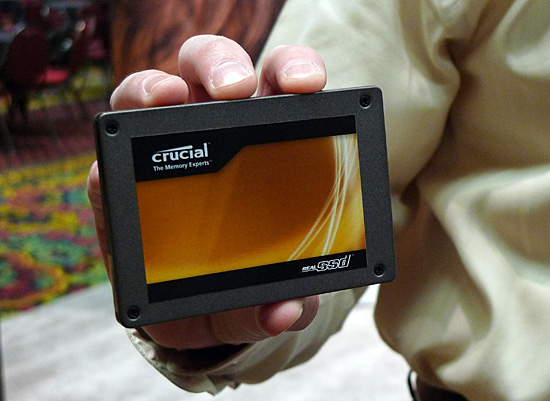
Faster than Intel? Perhaps.
The C300 is based on a new Marvell controller. It's the first consumer SSD to natively support 6Gbps SATA. The firmware and all of the write placement algorithms are developed internally by Micron and its team of 40 engineers. Micron tried using Marvell firmware in the past and quickly learned that it resulted in too much of a "HDD-like" experience (ahem, JMicron).
The Marvell controller features two ARM9 processor cores that operate in parallel. While they can load balance, one generally handles host requests while the other handles NAND requests.

Two ARM9 processors, Micron firmware, 256MB of external DRAM and 8-channels of MLC NAND flash
Adjacent to the controller is a massive 256MB DRAM. According to Micron, "very little" user data is stored in the DRAM. It's not used as a long term cache, but mostly for write tracking and mapping tables.
The controller internally doesn't have much cache on-die. Not nearly as much as Intel, according to Micron. While the original X25-M only had a 512KB SRAM, Micron claims that the latest G2 controller has a 2MB cache on-die. Micron x-rayed the chip to find out.
The write placement algorithms are similar in nature to what Intel does. There's no funny SandForce-like technology at work here. Every time a write is performed the controller does a little bit of cleanup to ensure that the drive doesn't get into an unreasonably slow performance state. Unlike Intel however, Micron does do garbage collection while the drive is idle. The idle garbage collection works independently of OS or file system.
TRIM is supported but only under Windows 7. There are no software tools to manually TRIM the drive. Micron hopes that its write placement algorithms and idle garbage collection will be enough to keep drive performance high regardless of OS.
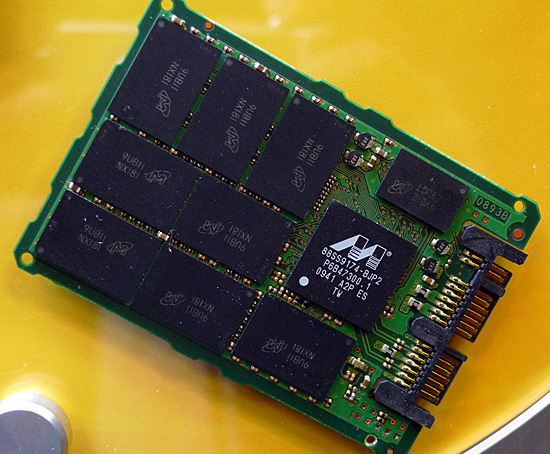
The RealSSD C300 will also be available in a 1.8" form factor for OEMs
Supporting 6Gbps SATA isn't enough to drive performance up. Micron is also using 34nm ONFI 2.1 NAND flash. The combination of faster NAND and a faster interface results in sequential read speeds of as much as 350MB/s. That's a full 100MB/s greater than the SandForce based OCZ Vertex 2 Pro we just previewed.
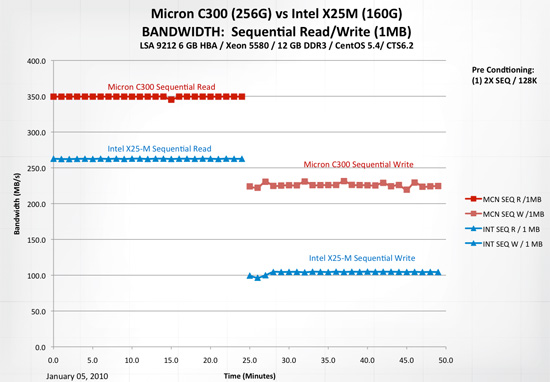
Write speeds don't set any records though. Micron claims the drive will do 215MB/s on sequential writes.
Random 4KB read/write speed appears to be X25-M class if not better. Micron only showed off peak numbers for a very short iometer run so we'll have to wait for me to get a drive before I can get a good idea of random performance.

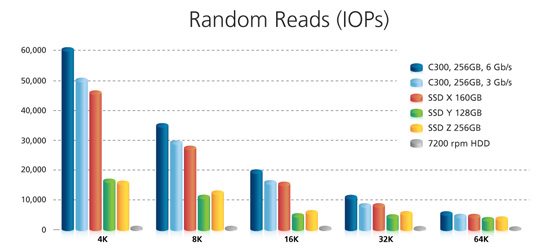
Micron does claim that the drive is more resilient than Intel's X25-M. Running a pure 4KB random write test across the entire drive's LBA space for 250 minutes (!) resulted in the following data:
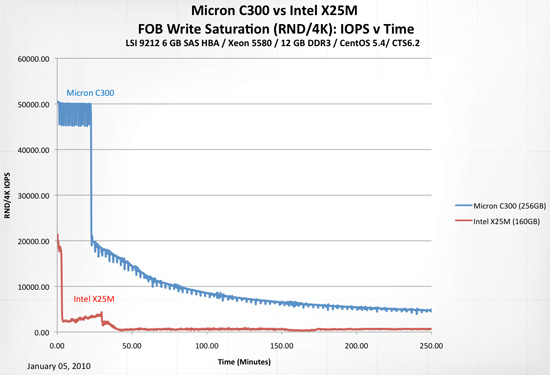
This workload is far more severe than anything you'd find on a desktop PC, but it does show that the RealSSD C300 appears to be fairly resistant to steep performance drops. The drive is completely unused prior to this test however.
PCMark Vantage performance is pretty impressive. On a SATA 3Gbps controller it appears to equal Intel's X25-M G2, but with a 6Gbps controller it is 23% faster if Micron's numbers can be believed.
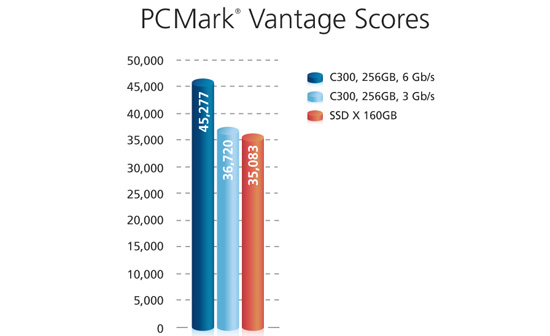
The issue of compatibility testing is a, err, non-issue. Micron already has a large compatibility lab for its memory. It just tests SSDs in the same lab now. Because Micron is going to be selling to OEMs the drives have to pass a 1000 hour qualification test before they can ship. The consumer drive will need 500 hours of test time before it can ship.
The Micron RealSSD C300 will be OEM-only, going after the same markets as Intel, Samsung and Toshiba. Crucial, Micron's retail arm, will sell direct to retail.
The Crucial RealSSD C300 will be available in two capacities: 128GB and 256GB with 7% of the NAND capacity used as spare area. The drives will be priced at $399 and $799 respectively. OEMs will get drives starting at the end of this month, but the Crucial drives will be available for purchase in February.
I'm already on the list for a review sample, so for now we wait.










33 Comments
View All Comments
jwilliams4200 - Monday, February 8, 2010 - link
Anand:Do you have a C300 for review yet?
Other sites have had them for more than a week...
minime - Sunday, January 10, 2010 - link
Could somebody enlighten me? Thanks!Chimel - Friday, February 19, 2010 - link
I second that, this graph is the most confusing of all and what it represents is not explained at all.I assume it refers to the fact that SSD disks become less efficient the more data is being written, but it's really not clear, especially all the acronyms, that "FOB" concept was not introduced in the previous SSD articles and benchmarks I read, Google does not even know what it is, unless Anand is ripping all albums from Fall Out Boy...
I also cannot understand why SSD drivers or firmware are not improved to fully solve this problem of loss of performance after usage. There are surely tons of technical solutions for it, like making use of disk idle times to defragment blocks and pages and spread the usage load, maybe even regularly move system or program files that are never modified to blocks of previously heavily written user data instead of aging the hidden spare space prematurely, etc.
SSD technology just doesn't look very mature yet, early adopters pay more than just the extra cost: $680 for 256GB is 27 times the price per GB of normal platters disks ($100/1TB). I'll wait for Windows 8 to benefit from the 25nm die and from cheaper, bigger, better and more stable hardware and software support and integration (and maybe faster SATA by that time!)
butrus ghali - Sunday, June 13, 2010 - link
FOB means Fresh Out of the Box.what raises a question though is why it is written that the C300 has never been used before when it is anyhow stated that the two drives at that graph are FOBs?!
:hmm:
butrus ghali - Sunday, June 13, 2010 - link
FOB means Fresh Out of the Box.what raises a question though is why it is written that the C300 has never been used before when it is anyhow stated that the two drives at that graph are FOBs?!
seems like anand is not the same guy who has made these graphs as stated that the next was provided by micron, and so probably don't know the answer to that as well himself :).
chizow - Thursday, January 7, 2010 - link
Anand,I'm sure you'll be extremely busy at CES over the next few days and may never read this, but if you do come across it and haven't done so already, could you do some comparisons in your next SSD round-up on SATA 6G Controllers for older 3G SSD drives?
Its been pretty well established in some of your reviews that current SATA 3G drives are fully saturating SATA 3G controller bandwidth, I'm wondering if there's any gain if those drives are paired with a SATA 6 controller.
I'd also be interested to see if essentially the same drives without any modification other than SATA 6G support would automatically scale beyond SATA 3G limitations if it is indeed a 3G spec/bandwidth limitation.
It really seems to me Intel is holding back performance of their drives in numerous ways, starting with SATA 3G limitations because their chipsets don't support SATA 6G yet (calculated business decision, imo), but also because they don't want their X25-M parts competing too closely with their X25-E parts.
They've already demonstrated significant speed increases on their 160GB X25-M with a simple firmware update boosting Seq. writes from 80MB/s to 110MB/s. From your dissection of their 160GB drive, there's even more room to improve on Seq. Write speed if they populate the other 10 NAND solder points for a 320GB drive, which should also boost Seq. Write speeds significantly.
529th - Thursday, January 7, 2010 - link
Be sure to post which controller is being used. I think there are two. The SF1500? & SF1200?cool, thanks :)
Ptosio - Thursday, January 7, 2010 - link
Let's forget about SATA6 for a moment.Could anyone explain me what's wrong with PCI Express for the SSDs? Where does all that fuss over SATA6 come from? I mean, PCIe has a bigger bandwidth than SATA3 (or doesn't it?) and is pretty much universal. SATA and 3.5/2.5 bays are specifically designed to support mechanical hard drives which quite obviously have different needs than regular chips containing no moving-parts...but isn't an SSD just that, a piece of logic? Can't it be treated as just another add-on card?
There are PCIe based SSD, but they're usually considered enterprise models. What prevents the PCI entering into regular consumer products? In other words, why we all rely solely on SATA when it obviously fails us?
(It's not a manifesto and I'm not pretending to be a smart guy, I'm just curious what's so great in SATA)
strikeback03 - Friday, January 8, 2010 - link
I'd imagine partly because it is easy to add more of them. Most motherboards have 6 SATA connectors and more can be added via PCIe cards, while motherboards tend to offer 2-4 PCIe connectors of all sizes, with 1 or more often already used by a GPU in an enthusiast system. They still want to be able to sell expensive SSDs to the people willing to spend for a 3way SLI or CF setup.vol7ron - Thursday, January 7, 2010 - link
(1) Could someone explain why 6Gb/s is seeing a performance increase over 3Gb/s?From my understanding, although SSDs were approaching the theoretical limit, they were still ~50MB/s away, which is a considerable amount (~17%).
Based on the facts here, it seems the only thing that would really be improving performance is the faster NAND.
(2) Do you think it's good marketing to charge $399 and $799? If that's the prices, could you please do another review of the SSDs in a RAID configuration (RAID-0 preferably). When I move to SSDs it will be on a 6Gbps channel at a minimal. I'd like to see 2 or 3 SSDs in RAID, including Intel's, OCZs, and this Micron (possibly even a Colossus for good measure).
(3) Please see my comment on page 9 of the Vertex Pro article (accidentally a double post). The overprovisioning units in the tables were wrong, throwing off your numbers, the Vertex is also using 6-7% spare area for consumers, not 13%.